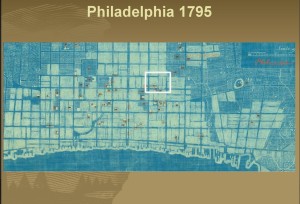February 2016 – Artifact of the Month
To Artifact of the Month Index
To PAF Home
~~~
What is a “Cupping Glass?”:
Medical Practice in Early 19th-Century America
“Cupping glass” discovered in Independence National Historical Park. The artifact is photographed laying on its side (left) and sitting upright atop a modern glass mounting ring (right). (Photos by A. Keim, Independence National Historical Park, Philadelphia, Pennsylvania.)
This two inch “cupping glass” was recovered by archaeologists working in Independence National Historical Park in Philadelphia, Pennsylvania. It was excavated from the site where the National Constitution Center museum now stands. This museum covers most of a full city block between 5th and 6th Streets and Arch and Race Streets. In the mid-eighteenth century, this block was a vibrant neighborhood that was densely packed with homes and businesses; it was also the site of the Second Presbyterian Church burial ground. The cupping glass illustrated here was one artifact discovered near the bottom of a privy pit (outhouse) that was located on the church property.

The location of the National Constitution Center block superimposed on a 1795 map of Philadelphia. (A. Keim, 2015).
What is a Cupping Glass?
“Cupping” is a medical tradition with roots that go back thousands of years; it was practiced in ancient Egypt, China, and elsewhere. The method involves placing cups on the skin in such a way as to create a suction. This is done by first warming the air in the cupping glass (usually by a flame) and, as the air inside cools, it forms a vacuum. The vacuum forms a suction that draws and pools the blood flowing beneath the skin under the cup. The suction was believed to promoted circulation of fluid in the body which was thought to promote healing. Cupping is still practiced today as a form of alternative medicine. (An image of this therapy can be found at the Cupping Therapy Wikipedia page here…. Note: Some may find this image alarming.)
Cupping in Early America
In early America cupping was associated with bloodletting which was a common therapy in the age of heroic medicine. Benjamin Rush (1746-1813), a prominent Philadelphia physician, humanitarian and reformer, was a well-known proponent of bleeding. He shared with his contemporaries the belief that health derived from a balance of the four humors in the body, one of which was blood. Cupping glasses facilitated the bloodletting that was thought to restore the body’s equilibrium by draining or purging the system of excess humors. A picture of a cupping set from the year circa 1810 can be found here..
Learn More…
News associated with this artifact discovery:
Independence Mall Dig Uncovers Colonial Graves Burial Plots For 15 Were Discovered. The Excavation Is Being Done To Prepare For The Constitution Center. By Saba Bireda, Philadelphia Inquirer, June 21, 2000
Constitution Center Site Bears Buried Links To The City’s Past By Charlene Mires, June 26, 2000
The Good, the Bad, and the Ugly:
Bioarchaeology and the Modern Gun Culture Debate [*PAGES 118-119 of which report and analyze gunshot victims in the Philadelphia archaeological record, namely ca. 1750–1799 burials at the Second Presbyterian Church Burial Ground excavated during construction of the National Constitution Center.By Thomas A. Crist, Historical Archaeology, 2006, 40(3):109–130.
____
This artifact of the month contribution, written by Patrice L. Jeppson and Jed Levin, draws upon a talk by Alexander Keim entitled, What is a “Cupping Glass?”: Medical Practice in Early 19th-C Philadelphia, presented at Explore Philly’s Buried Past, 2016!
by admin
